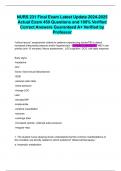Exam (elaborations)
NURS 231 Final Exam Latest Update Actual Exam 450 Questions and 100% Verified Correct Answers Guaranteed A+ Verified by Professor
- Course
- Institution
NURS 231 Final Exam Latest Update Actual Exam 450 Questions and 100% Verified Correct Answers Guaranteed A+ Verified by Professor
[Show more]



